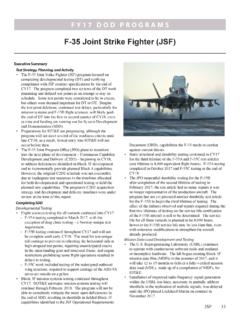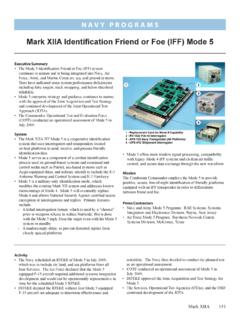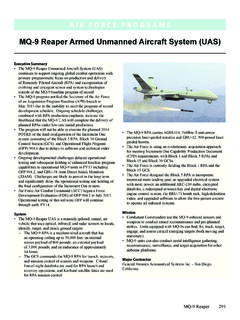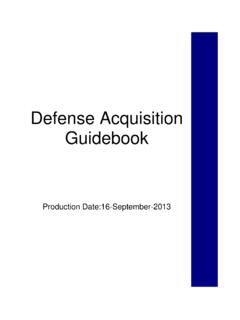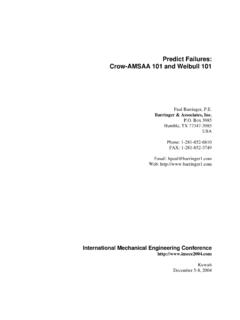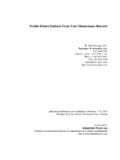Transcription of DOT&E Reliability Course
1 7/7/2016-1 DOT&E Reliability CourseCatherine WarnerMatthew AveryJonathan BellRebecca DickinsonLaura Freeman2 June 20167/7/2016-2 Course Objective and OverviewObjective Provide information to assist DOT&E action officers in their review and assessment of system Reliability . Overview and Agenda Course briefings cover Reliability planning and analysis activities that span the acquisition life cycle. Each briefing discusses review criteria relevant to DOT&E action officers based on DoD policies and lessons learned from previous oversight effortsTimeTopicPresenter0900 0920 Course IntroductionCatherineWarner0920 1000 RAM Requirements ReviewMatthew Avery1000 1045 Reliability Growth PlanningJonathan Bell1045 1100 Break1100 1145 Importance of Design Reviews in the Reliability Growth Planning Process1145 1245 Lunch Break1245 1330 TEMP Review and OT PlanningRebecca Dickinson1330 1400 Analysis of Reliability in DTRebecca Dickinson1400 1415 Break1415 1530 Analysis of RAM data for LRIP/BLRIP reportsMatthew Avery7/7/2016-3 Motivation for Improving System Reliability Improve system Reliability /meet thresholds Reduce O&S Costs Optimize test resources Quantify Risks Improve system
2 Safety/suitability for user Establish interim Reliability goalsSystem TypeFraction of Total CostRDT&EProcurementO&SGround Combat4%28%68%Rotary Wing4%31%65%Surface Ships1%39%60%Fighter Aircraft5%29%66%Majority of cost Research Development Test & Operations and from AEC/AMSAA Reliability Course Notes, 21 Aug Confidence Interval b. FY Fiscal Yearc. OT&E Operational Test and EvaluationWhy do it?DesignComplexity7/7/2016-4 Reliability must be designed into the product from the for Reliability (DfR) Understand user requirements and constraints Design and redesign for Reliability Produce reliable systems Monitor and assess user reliabilityA common problem failure: to reach desired initial system Reliability indicating failure in the design phase to engineer Reliability into the of Test Adequacy for Assessing Reliability1 360%10%20%30%40%50%60%70%80%90%100%10203 0405060 Cumulative Percent of Metrics(2013-2014 Assessment)Operational Test Length/Actual Requirement27%15%17%32%10%Design Margin= (80% power/50% confidence) Can reasonably demonstrate Reliability with 80% power/80% confidenceCan reasonably demonstrate Reliability with 80% power and between 50% and 80% confidenceTest length shorter than requirementSatisfies previous rule of thumbDoes not satisfy previous rule of thumbDesign Margin= (80% power/80% confidence)
3 Various methods are being used to develop adequate Reliability test lengths7/7/2016-6 TEMP Guidebook Reliability UpdatesReliability Growth Guidance Relatively unchanged from TEMP Guidebook Test Planning Guidance New section of the TEMP Guidebook Emphases the use of operating characteristic curves for planning operational tests Provides guidance on using data collected outside of an operational test for Reliability assessments7/7/2016-7 Systems AcquisitionSustainmentPre-Systems AcquisitionMaterial Solution Manufacturing DevelopmentProduction & DeploymentOperations& SupportABCIOCFOCM aterial Development DecisionPost-CDRA ssessmentPre-EMDR eviewFRPD ecision ReviewSystem Acquisition FrameworkSRRPDRCDRCDDCPDIDA Reliability Course TopicsRAM Requirements ReviewReliability Growth PlanningAssessment of Reliability in DTImportance of Design Reviews in Reliability Growth PlanningTEMP Review and OT PlanningTEMP Review and OT PlanningAnalysis of RAM data for BLRIP ReportsAnalysis of RAM data for LRIP ReportsTopics CoveredAcronyms.
4 BLRIP Beyond Low Rate Initial ProductionCDD Capabilities Development DocumentCDR Critical Design ReviewCPD Capabilities Production DocumentEMD Engineering & Manufacturing DevelopmentFOC Full Operational CapabilityIOC Initial Operational CapabilityLRIP Low Rate Initial ProductionRAM Reliability , Availability, MaintainabilitySRR Systems Requirement ReviewPDR Preliminary Design Review7/7/2016-8 TopicBriefing Purpose/ObjectivesReliability, Availability,Maintainability (RAM) Requirements Review Highlight the importance of reviewing RAMrequirements early in the program s lifecycle Discuss criteriathat should be considered during the review processReliability Growth Planning Provide an overviewof the importance and process of Reliability growth planning, focusing on information essential to supportreview of TEMPs and test plans Demonstratehow to use the Projection Methodology (PM2) and Crow Extended Reliability growth modelsImportance of DesignReviews in the Reliability Growth Planning Process Highlight the importance of design reviews in the Reliability Growth Planning process,and identify the relevant questions to consider during design reviews Provide programmatic examples of this Review and Operational Test (OT)
5 Planning Usingexamples, discuss how programs should document their Reliability growth plan in the TEMP Discuss criteriathat should be considered during the review process Describehow to assess the adequacy of an OT to evaluate reliabilityAnalysis of Reliability in Developmental Testing (DT) Explain how to determine if the proposed DT will be adequate to growth Reliability Provide an overviewof DTactivities that are essential to support Reliability assessment and tracking Analysis of RAM data for LRIP/BLRIP reports Discuss common methods for analyzing OT RAM data includingdevelopment of confidence bounds, analysis of censored data, comparison to baseline/legacy, estimation of the Reliability growth potential, subsystem failure analysis, etc. Software Reliability Describehow the procedures for Reliability growth planning and evaluation of software systems differ compared to hardware-based systemsTopics Covered (cont.)
6 7/7/2016-1 Reliability , Availability, Maintainability (RAM)Requirements ReviewInstitute for Defense Analyses4850 Mark Center Drive Alexandria, Virginia 22311-1882 Matthew AveryLaura Freeman12 November 20157/7/2016-2 Reliability in the DoD Context Operational mission Reliability Most complex defense systems serve more than one required function ( , ships may provide transportation, defense, self-protection, etc.) Multiple operating environments: desert, littoral, mountain, etc. Operating conditions vary depending on mission Requirements typically specify a fixed time period An additional consideration in operational mission Reliability Diverse population of system operators: crew-caused failures are still failures. Concept of operations / Design reference mission Essential for defining operational mission Reliability Defines standard mission length Provides a breakdown the expected activities during a mission Can change over time as operational missions evolveReliability: the ability of an item to perform a required function, under given environmentaland operating conditions and for a stated period of time (ISO 8402, International Standard: Quality Vocabulary, 1986)7/7/2016-3 Scoring the Severity of a Failure Operational Mission Failure (OMF) or System Abort (SA): failure discovered during mission execution that result in an abort or termination of a mission in progress Reliability requirements are typically written in terms of OMFsor Sas.
7 Essential Function Failures (EFF) or Essential Maintenance Action (EMA): failures of mission essential components. By definition all OMFs are EFFs EFFs include a large portion of the failure modes that drive maintenance costs and reduce system availability Comparing EFFs and OMFs Engine: temporary power failure vs. not starting at all Steering: excessive pulling in one direction vs. vehicle rolling Brakes: brake fluid leak/line worn vs. brake lock up 7/7/2016-4 Traditional Reliability Analysis A traditional Reliability analysis models the mean time between operational mission failures (MTBOMF) as a constant value (constant failure rate) Exponential distribution Failure mode is ignored Only operational test data is considered Reliability is calculated by: MMBOMF =TotalTime# of Failures7/7/2016-5 TimelineSystems AcquisitionSustainmentPre-Systems AcquisitionMaterial Solution Manufacturing DevelopmentProduction & DeploymentOperations& SupportABCIOCFOCM aterial Development DecisionPost-CDRA ssessmentPre-EMDR eviewFRPD ecision ReviewSystem Acquisition FrameworkSRRPDRCDRCDDCPDIDA Reliability Course TopicsRAM Requirements ReviewReliability Growth PlanningAssessment of Reliability in DTImportance of Design Reviews in Reliability Growth PlanningTEMP Review and OT PlanningTEMP Review and OT PlanningAnalysis of RAM data for BLRIP ReportsAnalysis of RAM data for LRIP ReportsAcronyms.
8 BLRIP Beyond Low Rate Initial ProductionCDD Capabilities Development DocumentCDR Critical Design ReviewCPD Capabilities Production DocumentEMD Engineering & Manufacturing DevelopmentFOC Full Operational CapabilityIOC Initial Operational CapabilityLRIP Low Rate Initial ProductionRAM Reliability , Availability, MaintainabilitySRR Systems Requirement ReviewPDR Preliminary Design Review7/7/2016-6 Topics Covered Importance of reviewing Reliability , Availability, Maintainability (RAM) requirements early in the program s lifecycle Criteria that should be considered when reviewing RAM requirements: What are your RAM requirements? Reliability , Availability, Maintainability Requirements By System Type (Single-Use, Repairable, One-off) Levels of Failure Aborts or Operational Mission Failures Failures or Essential Function Failures Non Essential Function Failures Mission-Level Reliability Requirements in the Mission Context Achievability of Requirements Assessing the Failure Definition Scoring Criteria (FDSC) and/or Joint Reliability & Maintainability Evaluation Team (JRMET)
9 Documents7/7/2016-7 Importance of Early Review of RAM requirements Requirements are generally established early in the program s lifecycle Before Milestone B for most programs The first step in acquiring reliable systems is ensuring that they have achievable, testable, and operationally meaningful Reliability requirements All systems have requirements Is this requirement operationally meaningful? Is this requirement achievable? How reliable are similar systems that have already been fielded? Is the requirement achievable given its Reliability growth plan? Is the requirement testable? Requirements Rationale in TEMP Starting at MS A Reliability , maintainability, availability requirements should be addressed if not adequately addressed in the requirements document When requirements are provided for all three metrics, DOT&EAO s should review to ensure they are mathematically consistent7/7/2016-8 Different Types of Systems Single-use systems System is destroyed upon use Missiles, rockets, MALD, etc.
10 Reliability is a simple probability ( , Probability kill > 90% ) Repairable Systems If the system breaks, it will be repaired and usage resumed Tanks, vehicles, ships, aircraft, etc. Reliability is typically time between events, , failures, critical failures, aborts, etc. A howitzer must have a 75 percent probability of completing an 18-hour mission without failure. A howitzer mean time between failures must exceed hours. One-off systems Only a single (or very few) systems will be produced Satellites, aircraft carriers, etc. Like a repairable system, though often very few chances to improve Reliability once system has been produced Often no assembly line leading to different Reliability concerns7/7/2016-9 Translating Reliability Requirements 90% probability of no Operational Mission Failure (OMF) over 24 hours Alternatively: Probability that time to failure > 24 hours is at least 90% What is the average Time to Failure ?
